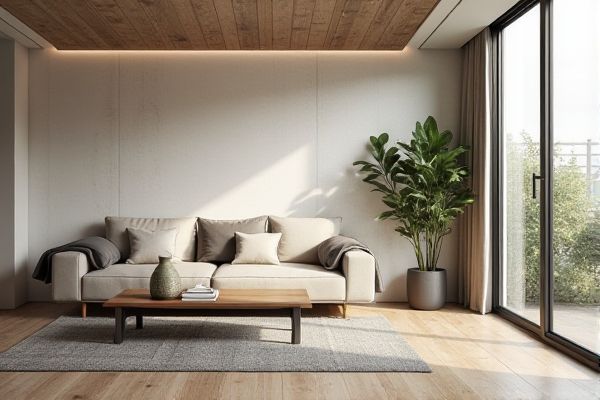
Wall cladding offers superior durability, weather resistance, and aesthetic appeal for terrace walls compared to traditional paint, which may require frequent touch-ups and offers limited protection against moisture and UV damage. Discover the key differences and find the best option to enhance and protect your terrace walls by reading the rest of the article.
Table of Comparison
| Feature | Wall Cladding (Terrace Walls) | Paint (Terrace Walls) |
|---|---|---|
| Durability | High; protects against weather, UV, and moisture | Moderate; requires periodic repainting every 3-5 years |
| Maintenance | Low; occasional cleaning and inspection | High; frequent touch-ups and repainting needed |
| Cost | Higher initial investment due to material and installation | Lower initial cost; cheaper materials and labor |
| Aesthetic Options | Variety of textures, colors, and materials (stone, wood, composite) | Wide range of colors; limited to flat or textured finishes |
| Weather Resistance | Excellent; resistant to rain, wind, UV rays | Good; may fade or peel under harsh weather |
| Installation Time | Longer; requires skilled labor | Shorter; can be applied quickly |
| Environmental Impact | Depends on material; some eco-friendly options available | Variable; low-VOC paints reduce toxic emissions |
| Thermal Insulation | Improves insulation and energy efficiency | Minimal impact on insulation |
| Longevity | 10-25 years depending on material quality | 3-7 years depending on paint quality and exposure |
Introduction to Terrace Wall Finishes
Terrace wall finishes significantly impact durability and aesthetics, with wall cladding offering enhanced weather resistance and insulation compared to traditional paint. High-quality materials like stone, wood, or composite cladding provide long-lasting protection against moisture and UV damage, reducing maintenance needs on exposed terrace walls. Paint, while cost-effective and versatile in color options, requires frequent touch-ups and protective coatings to withstand outdoor elements effectively.
What is Wall Cladding?
Wall cladding involves covering terrace walls with durable materials such as stone, wood, or composite panels to enhance protection and aesthetics. Unlike paint, which provides a thin, decorative layer prone to weathering, cladding offers increased resistance to moisture, UV rays, and temperature fluctuations. This structural layer improves insulation while reducing maintenance frequency and preventing surface deterioration over time.
What is Paint Finishing?
Paint finishing involves applying a protective and decorative coating directly onto terrace walls to enhance durability and aesthetic appeal. Unlike wall cladding, which uses external panels or materials to cover surfaces, paint acts as a sealed layer that guards against weather elements and moisture penetration. Your choice between paint finishing and cladding should consider factors like maintenance, cost, and desired texture for optimal terrace wall protection.
Durability: Cladding vs Paint
Wall cladding offers superior durability compared to paint on terrace walls, providing enhanced resistance against weather elements such as rain, UV rays, and temperature fluctuations. Unlike paint, which tends to peel, fade, or require frequent touch-ups every 2-5 years, cladding materials like stone, vinyl, or metal can last 20-50 years with minimal maintenance. Cladding also protects the underlying structure from moisture infiltration and physical damage, extending the life span of terrace walls significantly more than traditional paint coatings.
Weather Resistance Comparison
Wall cladding offers superior weather resistance for terrace walls compared to paint, as materials like stone, metal, or composite panels provide robust protection against moisture, UV rays, and temperature fluctuations. Paint may deteriorate over time due to peeling, cracking, and fading when exposed to harsh weather conditions, requiring frequent maintenance. Wall cladding's durability extends the lifespan of exterior surfaces, ensuring consistent protection and aesthetic appeal in diverse climates.
Maintenance Requirements
Wall cladding on terrace walls offers superior durability and requires less frequent maintenance compared to paint, which often demands regular touch-ups and repainting due to exposure to weather elements. Cladding materials such as stone, wood, or composite panels resist moisture, UV rays, and temperature fluctuations, reducing the need for cleaning and repairs. Choosing cladding for your terrace walls can save you time and effort in upkeep while maintaining an attractive appearance longer than paint.
Aesthetic Versatility and Design Options
Wall cladding offers greater aesthetic versatility for terrace walls, providing diverse materials like natural stone, wood, and metal that create unique textures and patterns unmatched by paint. Paint limits design options to color variations, while cladding can incorporate three-dimensional effects and integrates easily with outdoor elements for a more dynamic visual impact. Choosing wall cladding enhances durability and style, making it ideal for personalized terrace wall aesthetics that evolve beyond simple color changes.
Installation Process and Time
Wall cladding installation on terrace walls involves fixing panels made from materials like stone, wood, or composite using adhesives or mechanical fasteners, typically requiring several hours to a few days depending on the surface size and complexity. Painting terrace walls is a quicker process, generally completed within a day, involving surface preparation, priming, and applying multiple coats of paint. Wall cladding offers longer-lasting protection and durability but demands more installation time compared to the faster, cost-effective paint application.
Cost Analysis: Cladding vs Paint
Wall cladding for terrace walls typically involves higher upfront costs due to materials like stone, wood, or composite panels and professional installation, whereas paint offers a more budget-friendly initial solution with lower material and labor expenses. Cladding provides long-term durability and weather resistance, potentially reducing maintenance and repainting costs over time compared to painted surfaces that may require frequent touch-ups and reapplications. Your choice should consider both immediate budget constraints and long-term value based on maintenance and lifespan requirements.
Environmental Impact and Sustainability
Wall cladding for terrace walls often offers better environmental benefits compared to paint, as many cladding materials like natural stone, wood, or recycled composites are durable, reusable, and have low VOC emissions. Paint typically contains volatile organic compounds that contribute to air pollution and require frequent reapplications, increasing waste and resource consumption. Choosing cladding can enhance the sustainability of your terrace walls by reducing maintenance frequency and minimizing environmental harm.
 homyna.com
homyna.com